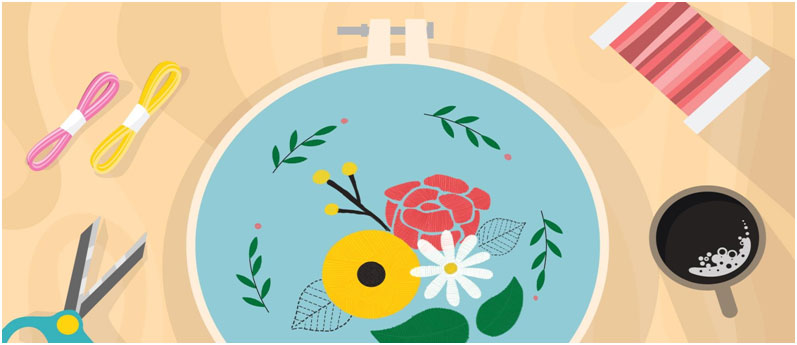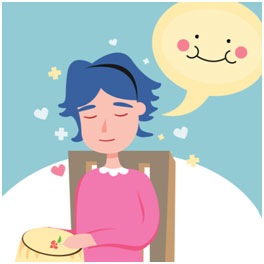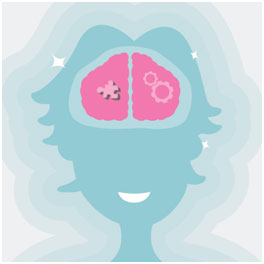

Introduction
Many of our modern associations with embroidery seem quaint–a cheeky cross-stitch pillow or needlepoint flowers. Yet embroidery is also a simple and powerful art form. Queen Elizabeth I often embroidered with other female rulers, and many artists today are now using the craft in radical ways just as women have long used embroidery for their own power. Like Chilean women of the 70s and 80s who created bright arpilleras to memorialize vanished family members and express resistance against Augusto Pinochet’s military dictatorship.
In your own home, though, embroidery can be just as powerful. Not as a form of politics or power, but also as a form of art therapy and mental healthcare.
This guide walks you through embroidery as a form of art therapy, including various mental health benefits of the craft, how to get started, and the materials you need to try your hand at a new form of mindfulness.
If you’re looking for inspiration for your next embroidery project, Bumblebee Linens is an online retailer that carries a wide variety of embroidered handkerchiefs, especially men’s handkerchiefs, ladies’ handkerchiefs, personalized dinner napkins, and monogrammed handkerchiefs.
What is Art Therapy?
Art therapy uses various forms of art media and the creative process as a form of integrative mental health care. The idea is simple: to enrich the lives of individuals and families and strengthen community ties through a combination of active art-making, applied psychological theory, the creative process, and human connection in the artistic and therapeutic relationship.
In art therapy, the artwork itself becomes a medium for the therapeutic and healing process. It recognizes that there are some emotions we can’t express in words. It also understands the healing power attached to the type of deep focus needed to make art.
In creating art, the client works toward greater self-awareness, self-esteem, and other key benefits.
Embroidery as an Art Therapy
The concept of embroidery as a form of art therapy is not new. In fact, we now have occupational therapy as a mainstay of medical practice because of embroidery.
After the First World War, doctors were dealing with a massive influx of shell-shocked soldiers who needed to readjust to civilian life. Embroidery was one of the methods they experimented with to help soldiers heal their mental scars, and it proved surprisingly effective.
The result was The Disabled Soldiers’ Embroidery Industry, which operated from 1918 to 1955 as a way for war-torn ex-servicemen to earn much-needed income while also rebuilding their self-esteem and sense of purpose. In the U.K., the technique is still used by organizations like Fine Cell Work, used by hundreds of prisons throughout Britain so that imprisoned men can find a respite from the clang and boom of prison life outside.
What is the Connection Between Embroidery and Mindfulness?
All of these organizations and their efforts point to a vital connection between embroidery and mindfulness.
Historically, embroidery has had both decorative and practical purposes–from ancient Persians who used quilt-making and weaving to craft armor to Western upper-class women who displayed luxury through decorative embroidery to working-class women who used needlework to practice mending. But as embroidery projects in the U.K., Australia, and New Zealand showed, embroidery also has powerful mindfulness benefits.
In a world of ever-decreasing attention spans and ever-increasing stress, embroidery forces us to slow down and be in the moment. There’s just you, your needle, your thread, the cloth, and your design. This is the root of mindfulness–taking the time to be present and focus on right now.
11 Ways Embroidery Boosts Your Mental Health
Of course, embroidery does quite a bit more than just keep you present in the here and now (although that is the root of its many mental health benefits). Here’s a closer look at some of the biggest mental health benefits of embroidery.
Reduces Stress and Anxiety
 Feeling stressed out? You’re not the only one. The good news is that embroidery can do wonders for your stress and anxiety levels.
Feeling stressed out? You’re not the only one. The good news is that embroidery can do wonders for your stress and anxiety levels.
Crafts ranging from knitting to baking to gardening have all been shown to improve mood and lower stress, and embroidery works the same way. It’s an act of multi-layered sensory engagement, and the focus, repetition, and anticipation of success are all associated with the neurotransmitters for joy and wellbeing while also reducing stress hormones.
On a more basic level, though, embroidery is an act of deep focus. This is an excellent remedy for stress and anxiety, which are all about getting stuck in your own head. Embroidery forces you to get out of your own head and focus on the task at hand, reducing your stress hormones as you focus on a task that you don’t associate with anxiety.
Using colors in embroidery can also help reduce stress and anxiety. Soft, neutral colors are known to help people relax, as do happy colors like gold, indigo, and magenta.
Lower Blood Pressure and Heart Rate
 Though cortisol is widely known as the body’s stress hormone, it has a variety of effects on your system. Basically, this is the hormone that prepared our ancestors to flee from oncoming lions, which means it regulates various body processes in order to ensure survival. One of these is raising your heart rate–the better to keep your brain working if you have to think fast or run.
Though cortisol is widely known as the body’s stress hormone, it has a variety of effects on your system. Basically, this is the hormone that prepared our ancestors to flee from oncoming lions, which means it regulates various body processes in order to ensure survival. One of these is raising your heart rate–the better to keep your brain working if you have to think fast or run.
Of course, in today’s world, most of us are not at imminent risk of death by lions. Our body doesn’t know that, though. It just processes the same chemicals and reactions we would have if we were staring down a lion. But those stress responses were designed for short-term survival. In the long-term, they’re detrimental to our overall health.
Here, again, embroidery can help.
Because embroidery gets us to stop focusing on whatever is stressing us out and focus instead on the task in front of us, it gets us out of the perpetual stress loop. In doing so, it tugs us out of the cycle that keeps our blood pressure and heart rate high as if we’re always being chased by lions.
Plus, seeing your beautiful and calming embroidery designs come to life can help lower blood pressure and heart rate all on its own. Nature-inspired designs like our Irish Linen Shamrock Embroidered handkerchiefs are especially good for this, as they help us feel more connected to the natural world, which has been shown to have a calming effect.
For this reason, embroidery can often feel like rest. For your body, it actually is!
Road to Recovery
 Stress isn’t the only cycle that embroidery can help you break. It can also help you shake off cycles of addiction and unhealthy behavior.
Stress isn’t the only cycle that embroidery can help you break. It can also help you shake off cycles of addiction and unhealthy behavior.
That was the case for Michelle Beaulieu-Morgan, a digital accessibility specialist at Yale University who rediscovered embroidery during 2015 in her Ph.D. According to her, reestablishing embroidery as a creative habit helped her get through her Ph.D. dissertation–and quit drinking.
“When I found embroidery, I finally and truly entered a real period of recovery for the first time in my life,” Beaulieu-Morgan wrote in a statement accompanying a Yale campus exhibition of her embroidered works.
The craft gave her something repetitive and compulsive to focus on in place of alcohol and other destructive behaviors. It also gave her a healthier outlet to deal with her anxiety and depression. Now it’s a central part of her life, and she spends 20 hours a week on the craft (with a dedicated Instagram following of 24,000).
Promotes Control
 One of the reasons embroidery is such an effective therapeutic technique is the powerful sense of control, a challenge for many people struggling with feelings of depression and anxiety.
One of the reasons embroidery is such an effective therapeutic technique is the powerful sense of control, a challenge for many people struggling with feelings of depression and anxiety.
You may not be able to control the world around you, but you can control how you approach your needle and thread. Every stitch is a conscious choice in your control, and each stitch is a step toward a final product.
That’s because art and active creativity (like what you use in embroidery) have been shown to release dopamine. This is a neurotransmitter that’s often low in people with chronic depression, anxiety, and stress.
Dopamine is released to make us feel happy, which scientists believe is a mechanism intended to promote behaviors that benefit our species, like eating, but it also plays a critical role in learning. When dopamine is released in response to an activity, it teaches us that an activity is positive and should be repeated, which is why positive reinforcement is so successful in education.
Emotional Release
 Of course, dopamine isn’t the only thing we release when we work on art. Artists across history have turned to their work as a means of releasing emotion, and embroidery works the same way–even for emotions you didn’t realize you wanted to express.
Of course, dopamine isn’t the only thing we release when we work on art. Artists across history have turned to their work as a means of releasing emotion, and embroidery works the same way–even for emotions you didn’t realize you wanted to express.
For many of us, complex emotions are difficult to express in words. But if we can’t express our feelings in a healthy way, we hold onto them, often without realizing it, and they motivate our behavior in other ways.
A creative outlet like embroidery gives you a chance to communicate using a different part of your brain than word processing, which is often exactly what you need to loosen your mental grip on lingering emotions.
Self-Discovery
 In the process, embroidery also creates space for self-discovery.
In the process, embroidery also creates space for self-discovery.
Imagine the feeling you get when you hold a stretch for a little while and release tension you didn’t even realize your muscles were holding. Emotions can often work the same way–we often subconsciously cling to emotions without realizing that we’re doing it.
The trick, of course, is that your brain needs a different stretch than your hamstrings. That’s where creativity comes in. Crafts like embroidery give you a chance to fire up different neural pathways and think differently than you would at work or school. In doing so, you get the chance to release things you didn’t realize you were holding–and even discover some things about yourself in the process.
Enhances Creativity
 This one should go without saying, but embroidery is a great way to enhance your creativity–even if you don’t consider yourself a creative person.
This one should go without saying, but embroidery is a great way to enhance your creativity–even if you don’t consider yourself a creative person.
As Kaitlin Knapp, the clinical program manager at Ascension St. Vincent and Peyton Manning Children’s Hospital, many people shy away from art therapy because they’re hyperfocused on the final product. They tend to respond the same way: “I haven’t done art since elementary school,” or “I can’t draw a straight line with a ruler.”
The key, Knapp says, isn’t the final product. It’s about the process. It’s not just about creating something pretty, either–it’s about celebrating your emotions, whatever that means in the moment and whatever that looks like for you. And once you give yourself permission to explore your emotions in this way, you’ll be surprised at your own ability to express yourself. When you see a colorful piece of embroidery that you worked on, it can serve as a reminder of how creative you really are. For example, this tutorial on DIY Heart Embroidered Handkerchiefs can be a great way to enhance creativity.
Builds Confidence
 Once you give yourself permission to express your feelings abstractly–and give yourself permission to tackle your embroidery project, whatever the end result may look like–the finished product and the process of getting there become an excellent confidence boost.
Once you give yourself permission to express your feelings abstractly–and give yourself permission to tackle your embroidery project, whatever the end result may look like–the finished product and the process of getting there become an excellent confidence boost.
Embroidery is unique from a lot of other arts in that you get to watch your project unfold literally one stitch at a time. Your efforts are physically reflected in an unfolding pattern. And with every stitch, you get another small reminder that you’re capable of doing what you set your mind to.
Builds Patience
 Granted, this process takes time (a lot of time). Which means embroidery is also excellent for mastering the art of patience.
Granted, this process takes time (a lot of time). Which means embroidery is also excellent for mastering the art of patience.
Unfortunately, we live in a world of instant gratification, and patience isn’t exactly a rewarded virtue. But embroidery is a physical art requiring time and physical effort, and while you can dedicate more time to get your project done faster, you can’t press fast-forward on the time it takes to craft a project stitch-by-stitch.
This makes it an excellent practice for those who need a reminder to slow down. If you have chronic anxiety, for example, waiting is on the short list of things you hate most in this world. Embroidery teaches you how to stop fretting about the future and take it one stitch at a time (literally).
Boost Cognitive Skills
 According to one study, crafting, reading, and playing games can reduce your risk of developing mild cognitive impairment by 30% to 50%. Crafting in particular is unique because it requires you to use multiple parts of your brain–not just your visuospatial processing, but also your memory, attention span, and problem-solving.
According to one study, crafting, reading, and playing games can reduce your risk of developing mild cognitive impairment by 30% to 50%. Crafting in particular is unique because it requires you to use multiple parts of your brain–not just your visuospatial processing, but also your memory, attention span, and problem-solving.
Who knew a humble needle and thread could do so much?
Our brains are surprisingly flexible (a feature called neuroplasticity). This is what allows us to adapt to new environments. The more we stimulate our brains, the more neuroplasticity we retain, which can boost our cognitive functioning even when we’re using a completely different skill set than embroidery.
Enhances Sleep Quality
 It should come as no surprise that an activity as soothing as embroidery would also benefit our sleep.
It should come as no surprise that an activity as soothing as embroidery would also benefit our sleep.
Part of why humans are excellent problem-solvers is that we turn over problems even when we’re no longer consciously thinking about them. This is why you might forget a name or date only to remember it hours later. Unfortunately, this also means that anxiety and stress can negatively impact our sleep, even if we’re not consciously worrying about something.
Because embroidery gives you an opportunity to let go of your stress and anxiety, it allows you to unravel a lot of that unconscious tension. In the process, you can give your conscious and unconscious mind a rest–and give yourself a boost in your quality of sleep.
This can affect sleep quality at various stages. It may help you fall asleep more easily, since you’ve reminded your brain how to let go of your stress and anxiety. But it can also ensure that once you fall asleep, you get better sleep and wake up more refreshed.
Embroidery projects like bath towels, pillowcases, and duvet covers can also serve as an excellent way to relax before bed. If you’re someone who struggles with falling asleep, using a calming, repetitive task like embroidery can help ease you into slumber.
Materials Needed
The good thing about embroidery is that it’s a cost-effective variety of art therapy. It requires a few supplies, but you can acquire most of them for a few bucks.
In order to start embroidering, you’ll need:
- Needle (crewel, tapestry, or milliner)
- Thread or embroidery floss
- Cloth or canvas
- A hoop or frame
- Sewing scissors
- A good lamp (for those who like embroidering at night)
- Thimble
- Water-soluble marker
- Beeswax (optional protection against fraying thread)
After that, all you need is a pattern and a patch of free time (preferably a sunny patch with your dog or cat).
How to Choose Material for Embroidery
In many cases, choosing a material is a question of figuring out what techniques you want to use and finding materials that are a good fit.
For example, some common embroidery fabrics include:
- Evenweave fabric
- Aida cloth
- Hardanger fabric
Each fabric has a different benefit. For example, tightly woven evenweave is good for surface embroidery, while loosely woven evenweave is good for drawn thread, pulled thread, and counted thread techniques. Aida is popular with cross-stitchers, while hardanger is great for hardanger, counted thread, blackwork, and cutwork.
How To Get Started With Embroidery
Once you have your supplies in hand, starting embroidery is quite easy.
Start by cutting a square of fabric a bit larger than your hoop. Loosen the hoop and place the outer hoop aside so that you can lay the fabric over the inner hoop. Then, push the outer hoop down over the inside hoop to sandwich your fabric between them.
Next, slowly tighten the outer hoop bit by bit, pausing to pull the fabric taut. The fabric should not give very much–if your fabric is too loose, it will make embroidery much harder. Keep tightening the outer hoop until it feels secure, but not so tightly that you can’t budge it (your fingers will regret it after a few hours of embroidery when you can’t adjust the hoop).
Next, it’s time to thread your needle. The easiest way is to take the end of your floss, wet it in your mouth, and squish it between your forefinger and thumb so that you have a flat surface that’s easy to push through the eye of the needle.
After that, you can get started with stitching. The simplest stitch is the running stitch, which works just like regular sewing. Use the traditional up and down, one-by-one stitch until you get the hang of spacing.
Et voila! You’re ready to get embroidering. You can learn more complex stitches, like the back stitch or split stitch, but the running stitch is all you really need to get started.
Conclusion
For those who need a little peace of mind and time for self-care, embroidery is a wonderful, simple, cost-effective activity to do a little art therapy at home–and create something beautiful in the meantime. We hope this guide has inspired you to try your hand at embroidery the next time you need a bit of mental health care.
————
If you know anyone suffering from mental health problems, here are a few resources to help someone in need:
- Crisis Text Line
- National Suicide Prevention Lifeline
- Veterans Crisis Line
- Disaster Distress Helpline
- Substance Abuse and Mental Health Services Administration (SAMHSA)
- Anxiety and Depression Association of America
- Depression and Bipolar Support Alliance
- Mental Health America
- National Alliance on Mental Illness
- CDC Mental Health Tools and Resources
- NIMH Help for Mental Illness
————-
References:
4 reasons craft is good for your mental health. (n.d.). [2020 June 15]. Crafts Council. Retrieved October 21, 2021, from https://www.craftscouncil.org.uk/stories/4-reasons-craft-good-your-mental-health
About Art Therapy. (n.d.). American Art Therapy Association. Retrieved October 21, 2021, from https://arttherapy.org/about-art-therapy/
Art Therapy Credentials Board. (n.d.). What is Art Therapy? | Art Therapy Credentials Board, Inc. Art Therapy Credentials Board. Retrieved October 21, 2021, from https://www.atcb.org/what-is-art-therapy/
Campbell, I. (2021, June 27). How Art Can Help Relieve Stress. Sage Neuroscience Center. https://sageclinic.org/blog/art-relieve-stress/
Department of Communication and Media. (2019, October 17). 10 Ways to Relieve Stress. Boise State University. https://www.boisestate.edu/comm-media/2019/10/17/10-ways-to-relieve-stress/
Fine Cell Work. (n.d.). Fine Cell Work. Retrieved October 21, 2021, from https://finecellwork.co.uk/
Gittlen, A. (2017, November 21). 11 Artists Using Embroidery in Radical Ways. Artsy. https://www.artsy.net/article/artsy-editorial-11-artists-embroidery-radical-ways
Gonzalez, S. (2019, September 23). Embroidery by staff member who’s recovered a stitch at a time on view. YaleNews. https://news.yale.edu/2019/09/23/embroidery-staff-member-whos-recovered-stitch-time-view
Guest Author for www.rtor.org. (2018, July 10). Creativity and Recovery: The Mental Health Benefits of Art Therapy. RTOR. https://www.rtor.org/2018/07/10/benefits-of-art-therapy/
Hunter, C. (2019, February 23). The calming effects of sewing can help people express and heal themselves. The Guardian. https://www.theguardian.com/lifeandstyle/2019/feb/23/the-calming-effects-of-sewing-can-help-people-express-and-calm-themselves
Kaimal, G., Ray, K., & Muniz, J. (2016). Reduction of Cortisol Levels and Participants’ Responses Following Art Making. Art Therapy, 33(2), 74–80. https://doi.org/10.1080/07421656.2016.1166832
Kaitlin Knapp on advocating for creative arts therapies. (2021, July 1). Herron School of Art + Design. https://herron.iupui.edu/news-events/stories/2021-07-01-kaitlin-knapp-daa.html
McBrinn, J. (2018). ‘The work of masculine fingers’: The Disabled Soldiers’ Embroidery Industry, 1918–1955. Journal of Design History, 31(1), 1–23. https://doi.org/10.1093/jdh/epw043
McLeod, L. (2021, April 5). The History of Embroidery Art and Contemporary Practitioners. Arts Help. https://www.artshelp.net/the-history-of-embroidery-art-and-contemporary-practitioners/
Sarah. (2020, June 30). Benefits of Hand Embroidery. Sarah’s Hand Embroidery Tutorials. https://www.embroidery.rocksea.org/benefits-of-hand-embroidery/
Thau, L., Gandhi, J., & Sharma, S. (2021). Physiology, Cortisol. In StatPearls. StatPearls Publishing. http://www.ncbi.nlm.nih.gov/books/NBK538239/
Ye, G., Hm, T., La, R., Ro, R., Ds, K., Vs, P., Tj, C., Bf, B., Eg, T., Rj, I., & Rc, P. (2011). Engaging in cognitive activities, aging, and mild cognitive impairment: A population-based study. The Journal of Neuropsychiatry and Clinical Neurosciences, 23(2). https://doi.org/10.1176/jnp.23.2.jnp149
Zaidel, D. W. (2014). Creativity, brain, and art: Biological and neurological considerations. Frontiers in Human Neuroscience, 8, 389. https://doi.org/10.3389/fnhum.2014.00389







